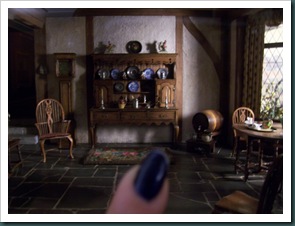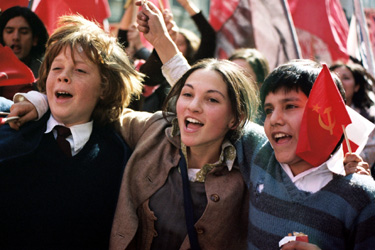Kate Winslet won big at 2009’s Golden Globes and Academy Awards for The Reader. She was on fire, but Winslet and DiCaprio’s mutual admiration ass-kissing club got to me with the: “he’s the best actor of his generation/she’s the best actress of her generation.” I opted *not* to see The Reader, despite all the hubbub.
I’d read the book years ago and recalled feeling lackluster. When Michelle brought the movie to Brian’s, I wasn’t chomping at the bit to see it. Once we started watching it, however, I was there (fast and furious-like) in pre-WWII Germany.
and recalled feeling lackluster. When Michelle brought the movie to Brian’s, I wasn’t chomping at the bit to see it. Once we started watching it, however, I was there (fast and furious-like) in pre-WWII Germany.
(Spoiler Alert: Read at Your Own Risk!)
German Hanna Schmitz (Kate Winslet) works as an attendant on the trolley transportation. Teenager Michael Berg (David Kross) meets much older woman Hanna and they begin a clandestine sexual relationship lasting all summer. Part of their trysts involve Michael reading to her. He reads The Odyssey, The Lady with the Little Dog and the Adventures of Huckleberry Finn. As Michael falls deeper and deeper for Hanna, he finds that Hanna can’t let her walls down; this leads to several rows. Michael is dismayed when he stops by to see her after school one day and finds she has absconded without a trace. Fast-forward nearly 10 years, Michael is in law school. His class is attending Nazi war crimes trial, when he is amazed to discover that his former lover, Hanna, is among the defendants. This re-opens the never-quite-healed wound of Hanna Schmitz. This time, Michael will learn devastating facts about his enigmatic first love.
Winslet is an acting goddess. She is Hanna Schmitz and wholly deserving of her awards. I do agree with DiCaprio’s assessment of her as one of the best actresses of her generation…I just wish he’d let us make that determination. The Reader is stellar and I will re-read the book and hope I get something different out of it this time.
Director: Stephen Daldry
Country: US
Genre: Drama
Run time: 123 minutes
Scale: 5































 Parisian Philippe Petit grows up with a passion for tightrope/high wire walking. He starts young and takes his act to the streets, setting up small-scale tightropes, performing for Parisians. The movie does contain clips of Petit in his youth (late teens and early 20s practicing) and his co-conspirators during their planning sessions, but it’s exciting to see the footage and see how they aged.
Parisian Philippe Petit grows up with a passion for tightrope/high wire walking. He starts young and takes his act to the streets, setting up small-scale tightropes, performing for Parisians. The movie does contain clips of Petit in his youth (late teens and early 20s practicing) and his co-conspirators during their planning sessions, but it’s exciting to see the footage and see how they aged. relationship with Kenneth is over and she’s been demoted. The Alphabet Killer is killing young girls. Megan begs Kenneth to let her get involved with the case again, but on a detective-light scale. Kenneth allows it and partners her up with Officer Steven Harper (Tom Malloy). They begin making connections. Megan stops taking her meds. She starts hearing the voices and seeing the apparitions again. She hides this and continues on the case. After a few false leads, they are finally getting somewhere. Until the next breakdown involving a priest and Megan flailing and shooting a gun in a church. She’s hospitalized again but in an unlikely scenario, she breaks out to keep following up on the case. We are then presented with the bizarre, improbable and confusing climactic ending, which leaves you as confused as Megan.
relationship with Kenneth is over and she’s been demoted. The Alphabet Killer is killing young girls. Megan begs Kenneth to let her get involved with the case again, but on a detective-light scale. Kenneth allows it and partners her up with Officer Steven Harper (Tom Malloy). They begin making connections. Megan stops taking her meds. She starts hearing the voices and seeing the apparitions again. She hides this and continues on the case. After a few false leads, they are finally getting somewhere. Until the next breakdown involving a priest and Megan flailing and shooting a gun in a church. She’s hospitalized again but in an unlikely scenario, she breaks out to keep following up on the case. We are then presented with the bizarre, improbable and confusing climactic ending, which leaves you as confused as Megan. My only question…WHY? In fairness, I watched the first hour. It was painful and I turned it off. Don’t let yourself be fooled by the miniscule moments of humor on which the trailer desperately focuses. It’s not funny. There are tiny moments where you chuckle, but that’s it!
My only question…WHY? In fairness, I watched the first hour. It was painful and I turned it off. Don’t let yourself be fooled by the miniscule moments of humor on which the trailer desperately focuses. It’s not funny. There are tiny moments where you chuckle, but that’s it! large helping of tough love, instructing them to become familiar with living, that that’s what they must do. Elling isn’t convinced. After Frank leaves, they move the second bedroom bed into the first bedroom, separated by a night table. Now, they are roommates again, just like in the institution. When Kjell attracts the attention of the kooky pregnant neighbor, Elling is fearful. He’s going to have to break out on his own. Soon, he discovers his calling in poetry.
large helping of tough love, instructing them to become familiar with living, that that’s what they must do. Elling isn’t convinced. After Frank leaves, they move the second bedroom bed into the first bedroom, separated by a night table. Now, they are roommates again, just like in the institution. When Kjell attracts the attention of the kooky pregnant neighbor, Elling is fearful. He’s going to have to break out on his own. Soon, he discovers his calling in poetry.







 Japanese filmmakers know how to spin horror. The cinematography here employs shots that focus, then close-in on characters having them looking directly into the camera. Angles draw you into the action. Slow at turns, you don’t get the extreme sense of urgency and heightened tension until near the end, where you are morphed from one plane to another.
Japanese filmmakers know how to spin horror. The cinematography here employs shots that focus, then close-in on characters having them looking directly into the camera. Angles draw you into the action. Slow at turns, you don’t get the extreme sense of urgency and heightened tension until near the end, where you are morphed from one plane to another. Tyson mumbles fast and softly. You don’t miss much but a few times, what he says isn’t immediately clear.
Tyson mumbles fast and softly. You don’t miss much but a few times, what he says isn’t immediately clear. 
 When naive Harvard hopeful Harper meets beguiling photographer Connie at her sister’s wedding, she’s intrigued, despite their considerable age difference. The two become friends. Connie proposes mentoring Harper in the arts. Harper is enticed, but she has no idea what she would “study.” With his help, she decides on photography and their relationship begins. Her Harvard Law-educated parents and sister expect she will follow in their footsteps. Connie senses she doesn’t want that and urges her to find her passion. The odd coupling of Harper’s awkwardness juxtaposed with Connie’s manipulative, charming belief in her is interesting; the ending bothers me.
When naive Harvard hopeful Harper meets beguiling photographer Connie at her sister’s wedding, she’s intrigued, despite their considerable age difference. The two become friends. Connie proposes mentoring Harper in the arts. Harper is enticed, but she has no idea what she would “study.” With his help, she decides on photography and their relationship begins. Her Harvard Law-educated parents and sister expect she will follow in their footsteps. Connie senses she doesn’t want that and urges her to find her passion. The odd coupling of Harper’s awkwardness juxtaposed with Connie’s manipulative, charming belief in her is interesting; the ending bothers me. ensions heighten between the wealthy (Gonzalo and his family) and the impoverished (Machuca’s family). This, ultimately, roadblocks the blossoming friendship. Quer’s expressive face brings great life to Gonzalo’s character. His happiness at his new friendship and experiences is palpable. Machuca’s lack of fear in the face of the bully and authority provides Gonzalo courage. When they both fall for same girl who seems to prefer Gonzalo (although she constantly criticizes him calling him a rich snob), their friendships begins its descent.
ensions heighten between the wealthy (Gonzalo and his family) and the impoverished (Machuca’s family). This, ultimately, roadblocks the blossoming friendship. Quer’s expressive face brings great life to Gonzalo’s character. His happiness at his new friendship and experiences is palpable. Machuca’s lack of fear in the face of the bully and authority provides Gonzalo courage. When they both fall for same girl who seems to prefer Gonzalo (although she constantly criticizes him calling him a rich snob), their friendships begins its descent. Part of the 6 Películas para no dormir anthology (6 Films to Keep You Awake), this double-feature is scary. More psychological than gory (although you do get gore), both features play upon some of our deepest-seeded fears. In La habitación del niño, a Spanish couple—Sonia (Leonor Watling) and Juan (Javier Gutiérrez)—and their baby, move into their dream home: a lovely fixer-upper in need of serious work. When Juan’s sister and brother-in-law stop by for an unannounced visit, it’s not just frustration they cause. They leave the couple with a set of baby monitors to enable them to keep tabs on their boy without having to leave their room. When the baby monitors seem to malfunction, Juan invests in a infra-red video monitor so they can not only hear but also see baby, which leads to the trouble. Juan starts seeing an intruder in the baby’s room; problem is Sonia doesn’t. Is it in Juan’s imagination or is there paranormal activity in the baby’s room? And, who is this strange woman who speaks about no good coming out of their new home? The couple’s relationship suffers as Juan’s sanity is questioned, but what is he seeing in that monitor? The size of the house and it’s mess create an eerie atmosphere.
Part of the 6 Películas para no dormir anthology (6 Films to Keep You Awake), this double-feature is scary. More psychological than gory (although you do get gore), both features play upon some of our deepest-seeded fears. In La habitación del niño, a Spanish couple—Sonia (Leonor Watling) and Juan (Javier Gutiérrez)—and their baby, move into their dream home: a lovely fixer-upper in need of serious work. When Juan’s sister and brother-in-law stop by for an unannounced visit, it’s not just frustration they cause. They leave the couple with a set of baby monitors to enable them to keep tabs on their boy without having to leave their room. When the baby monitors seem to malfunction, Juan invests in a infra-red video monitor so they can not only hear but also see baby, which leads to the trouble. Juan starts seeing an intruder in the baby’s room; problem is Sonia doesn’t. Is it in Juan’s imagination or is there paranormal activity in the baby’s room? And, who is this strange woman who speaks about no good coming out of their new home? The couple’s relationship suffers as Juan’s sanity is questioned, but what is he seeing in that monitor? The size of the house and it’s mess create an eerie atmosphere.
